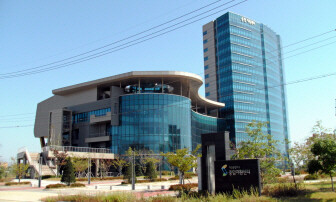hankyoreh
Links to other country sites 다른 나라 사이트 링크
Business is booming at Kaesong complex

By Kim Kyu-won, Staff Writer
The number of North Korean workers employed at Kaesong Industrial Complex has passed the 50,000 mark for the first time. Output is also increasing, having reached $400 million (448 million won) a year.
“Following the supply of an additional 449 workers on January 26 by the North, the number of North Korean workers working at Kaesong Industrial Complex has now reached 50,315,” stated Seo Ho, head of the Ministry of Unification’s Inter-Korean Cooperation District Support Directorate on Wednesday. In 2004, 55 North Korean workers were employed at the complex. This number grew to reach 23,529 under the Roh Moo-hyun government in 2007 and has steadily increased under Lee Myung-bak’s rule.
The majority of the 50,000 workers are believed to come from the city of Kaesong, while others are from the nearby counties Jangpung-gun and Gaepung-gun. An investigation has shown that 72% of the North Korean workers are female, while those in their thirties and forties comprise 68% of the workforce. Given that the population of Kaesong City is around 300,000, a considerable number of young and middle-aged women in Kaesong and the surrounding area are presumed to work at the complex.
Currently, an average of 390 North Korean workers is employed at each of 123 firms at the complex. Their average monthly wage is 110 dollars. After tax and insurance payments, workers are known to take home around 55% of this. “I understand that one worker’s wages at Kaesong Industrial Complex can provide for around four people,” Seo stated.
Accumulated output since 2004 has exceeded 1.5 billion dollars. Textiles account for more than 50% of the plant’s total output, followed by electrical and electronic goods, metals and machinery and chemicals.
But the complex, the only current economic cooperation project between South and North Korea, has a long way to go. The most urgent task is providing transport and accommodation to allow the supply of around 20,000 additional workers that are currently needed. Easier passage, communications and customs checks are important, too. The South wants the border to be open 24 hours a day, mobile phone and Internet access, along with more relaxed customs checks. Another significant task that remains is obtaining recognition for the complex as a South Korean extraterritorial place of manufacture as part of the South’s Free Trade Agreements with the EU and the US.
Please direct questions or comments to [englishhani@hani.co.kr]
Editorial・opinion
![[Column] Season 2 of special prosecutor probe may be coming to Korea soon [Column] Season 2 of special prosecutor probe may be coming to Korea soon](https://flexible.img.hani.co.kr/flexible/normal/500/300/imgdb/original/2024/0426/3317141030699447.jpg) [Column] Season 2 of special prosecutor probe may be coming to Korea soon
[Column] Season 2 of special prosecutor probe may be coming to Korea soon![[Column] Park Geun-hye déjà vu in Yoon Suk-yeol [Column] Park Geun-hye déjà vu in Yoon Suk-yeol](https://flexible.img.hani.co.kr/flexible/normal/500/300/imgdb/original/2024/0424/651713945113788.jpg) [Column] Park Geun-hye déjà vu in Yoon Suk-yeol
[Column] Park Geun-hye déjà vu in Yoon Suk-yeol- [Editorial] New weight of N. Korea’s nuclear threats makes dialogue all the more urgent
- [Guest essay] The real reason Korea’s new right wants to dub Rhee a founding father
- [Column] ‘Choson’: Is it time we start referring to N. Korea in its own terms?
- [Editorial] Japan’s rewriting of history with Korea has gone too far
- [Column] The president’s questionable capacity for dialogue
- [Column] Are chaebol firms just pizza pies for families to divvy up as they please?
- [Column] Has Korea, too, crossed the Rubicon on China?
- [Correspondent’s column] In Japan’s alliance with US, echoes of its past alliances with UK
Most viewed articles
- 1‘We must say no’: Seoul defense chief on Korean, USFK involvement in hypothetical Taiwan crisis
- 2Is Japan about to snatch control of Line messenger from Korea’s Naver?
- 3[Editorial] Korea’s surprise Q1 growth requires objective assessment, not blind fanfare
- 4Division commander ordered troops to enter raging flood waters before Marine died, survivor says
- 5No good, very bad game for Korea puts it out of Olympics for first time since 1988
- 6Korea’s 1.3% growth in Q1 signals ‘textbook’ return to growth, says government
- 7[Reportage] On US campuses, student risk arrest as they call for divestment from Israel
- 8N. Korean delegation’s trip to Iran shows how Pyongyang is leveraging ties with Moscow
- 9Flying “new right” flag, Korea’s Yoon Suk-yeol charges toward ideological rule
- 10[Column] Park Geun-hye déjà vu in Yoon Suk-yeol